刚开始接触java时,就觉得多线程是一个障碍,不容易理解,当时选择了跳过,不过工作一段时间后,发现这块还是需要深入研究一下的,及时平时工作中不使用多线程,但一定会使用web容器,比如tomcat,也是会接触到多喜爱能成,况且现在工作中也是需要使用到多线程。首先从简单的开始,了解线程的状态,查看Thread源码,与getState方法在一起的有个枚举State,其包含了线程的所有状态
JDK版本为1.8

public enum State { /** * Thread state for a thread which has not yet started. */ NEW, /** * Thread state for a runnable thread. A thread in the runnable * state is executing in the Java virtual machine but it may * be waiting for other resources from the operating system * such as processor. */ RUNNABLE, /** * Thread state for a thread blocked waiting for a monitor lock. * A thread in the blocked state is waiting for a monitor lock * to enter a synchronized block/method or * reenter a synchronized block/method after calling * {@link Object#wait() Object.wait}. */ BLOCKED, /** * Thread state for a waiting thread. * A thread is in the waiting state due to calling one of the * following methods: * <ul> * <li>{@link Object#wait() Object.wait} with no timeout</li> * <li>{@link #join() Thread.join} with no timeout</li> * <li>{@link LockSupport#park() LockSupport.park}</li> * </ul> * * <p>A thread in the waiting state is waiting for another thread to * perform a particular action. * * For example, a thread that has called <tt>Object.wait()</tt> * on an object is waiting for another thread to call * <tt>Object.notify()</tt> or <tt>Object.notifyAll()</tt> on * that object. A thread that has called <tt>Thread.join()</tt> * is waiting for a specified thread to terminate. */ WAITING, /** * Thread state for a waiting thread with a specified waiting time. * A thread is in the timed waiting state due to calling one of * the following methods with a specified positive waiting time: * <ul> * <li>{@link #sleep Thread.sleep}</li> * <li>{@link Object#wait(long) Object.wait} with timeout</li> * <li>{@link #join(long) Thread.join} with timeout</li> * <li>{@link LockSupport#parkNanos LockSupport.parkNanos}</li> * <li>{@link LockSupport#parkUntil LockSupport.parkUntil}</li> * </ul> */ TIMED_WAITING, /** * Thread state for a terminated thread. * The thread has completed execution. */ TERMINATED; }
通过以上代码了解到,线程有六种状态:NEW、RUNNABLE、BLOCKED、WAITING、TIMED_WAITING、TERMINATED
根据个人理解,简单列出了各状态之间的转换
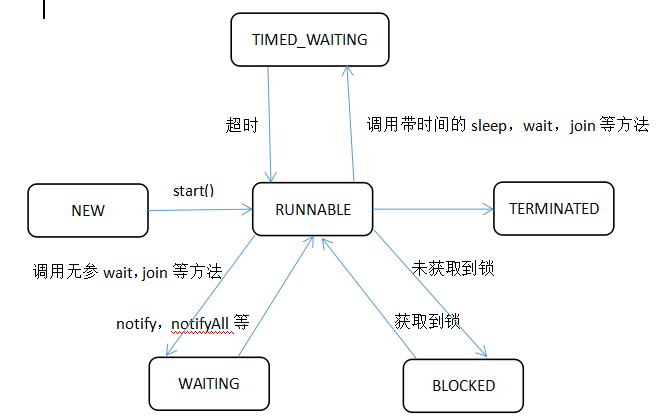
NEW到RUNNABLE状态不可回退
RUNNABLE到TERMINATED状态不可回退
代码验证NEW,RUNNABLE和TERMINATED状态
package com.demo; public class ThreadTest { public static void main(String[] args) { Thread t = new Thread() { @Override public void run() { System.out.println("run"); } }; System.out.println(t.getState()); // NEW,还未调用start方法 t.start(); System.out.println(t.getState()); // RUNNABLE,调用了start方法,但线程还未结束 try { // 等待线程结束,其实休眠毫秒级应该就可以结束 Thread.sleep(1000); } catch (InterruptedException e) { e.printStackTrace(); } System.out.println(t.getState());// TERMINATED,线程结束 } }
输出结果
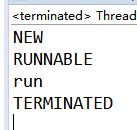
验证BLOCK与WAITING状态
package com.demo; public class ThreadTest { public static void main(String[] args) { Runnable r = new Runnable() { @Override public void run() { synchronized (this) { try { Thread.sleep(50000); } catch (InterruptedException e) { // TODO Auto-generated catch block e.printStackTrace(); } } } }; Thread t1 = new Thread(r, "Thread1"); Thread t2 = new Thread(r, "Thread2"); // 优先级数字范围为1到10,默认5,数字越小,优先级越高 t1.setPriority(5); t2.setPriority(8); t1.start(); t2.start(); } }
打包成jar包,java -cp thread.jar com.demo.ThreadTest
ps找到对应的pid
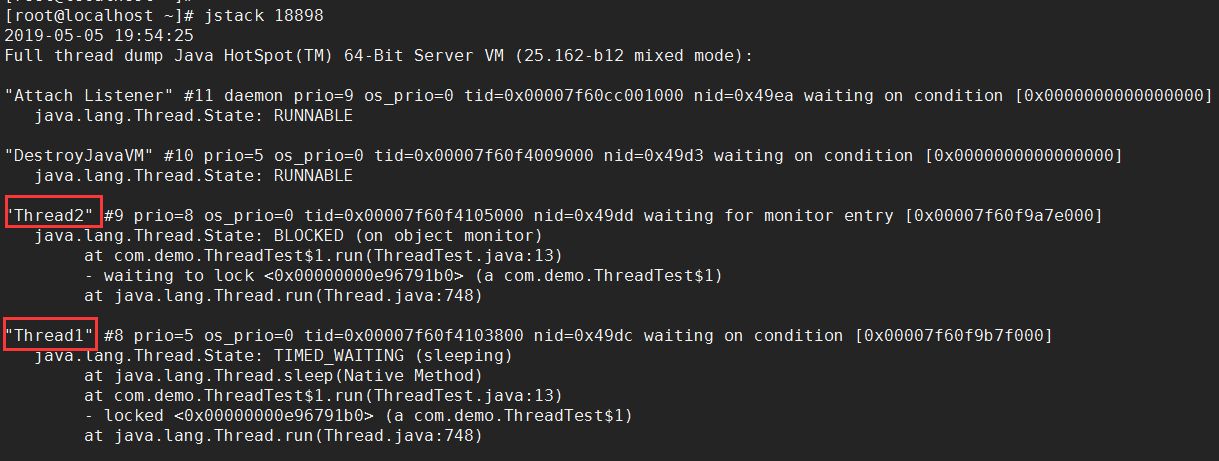
Thread1优先执行,获取到锁,调用了sleep方法,处于TIMED_WAITING状态,Thread2未获取到锁,处于BLOCKED状态
将上述测试中Thread.sleep方法改为this.wait()
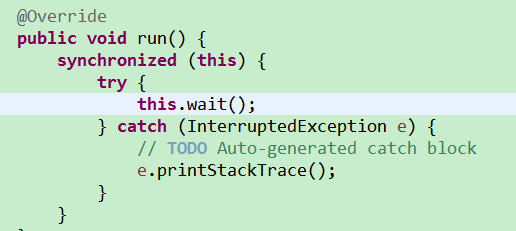
jstack查看结果
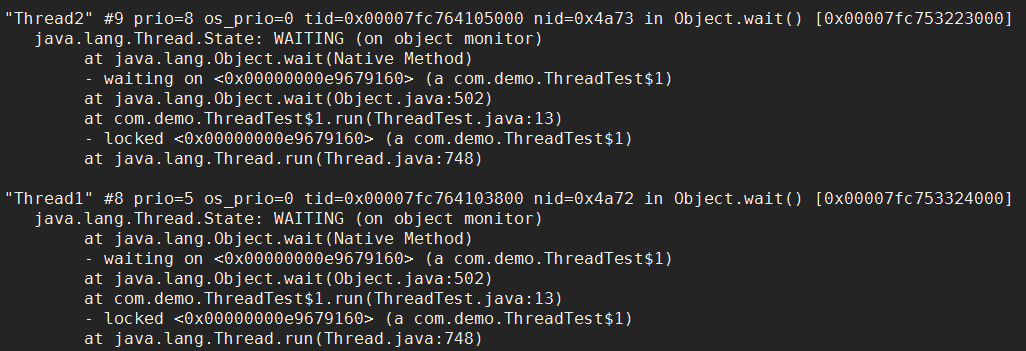
调用wait方法释放了锁,所以两条线程依次进入到synchronized代码块,处于WAITING状态,只有等到被notify或者notifyAll才能恢复为RUNNABLE状态,而有参的sleep或者wait等方法,则可以在制定的时间过后,自动变为RUNNABLE状态。
验证TIMED_WAITING状态
向this.wait方法传递参数

jstack查看结果

两条线程均处于TIMED_WAITING状态,说明它们同样都获取到了锁,wait方法,无论是否带参数,都会释放锁,但sleep不会释放锁
yield方法
不推荐使用,按照源码中注释所述,该方法使当前线程释放锁,释放对处理器的占用。但很少有适合使用该方法的场景,在debug或者测试或者设计并发控制结构,如juc包中的数据结构时可能会比较有用,不需要特别的关注该方法
暂停(suspend),重新开始(resume),销毁(destory)由于死锁问题,已经被标记为过时,不推荐使用
中断(interrput)
该方法在一些地方使用时,会抛出异常,比如在一个由于sleep方法被阻塞的线程上使用该方法,将抛出InterruptedException异常,具体可查看源码。
interrput方法并非真正的中断了线程,只是在该线程上设置了一个中断标志,如果需要中断线程中的后续操作,还需要在线程内部写一些代码配合使用
package com.demo; public class ThreadTest { public static void main(String[] args) { Thread t = new Thread(new MyRunnable(), "mythread"); t.start(); t.interrupt(); } } class MyRunnable implements Runnable { int j = 0; @Override public void run() { System.out.println("中断状态:" + Thread.currentThread().isInterrupted()); System.out.println("线程状态:" + Thread.currentThread().getState()); for (int i = 0; i < 100000; i++) { j++; } System.out.println(j); } }
输出结果

可以看出,在for循环还未执行的时候,线程已经处于中断状态,但并未真正的中断,for循环已经被执行了,因此,interrupt方法只是设置了中断状态标志为true,并未真正的中断线程。可以根据线程状态,做一些操作,来达到类似中断线程的效果
如上代码,在for循环中,加入判断条件

输出结果

可以看出,线程处于中断状态,for循环的j没有累加。为了看的比较真切,可以在中断之前,休眠一段时间,比如sleep 3毫秒,输出结果

为什么wait和notify,notifyAll方法被定义到了Object中,而不是在Thread中?
根据wait,notify,notifyAll方法源码注释可知,这几个方法必须在synchronized内部使用,而synchronized使用的锁是任意的,我们在锁上调用wait和notify方法来完成线程间通信,也即是说,对于所有对象,wait和notify以及notifyAll方法都必须是可以使用的,所有对象都可使用的方法,那就要放到Object中了,如果将wait和notify方法放入到Thread线程类中,那么锁的类型就极大的被缩减到一种(必须是Thread或其子类)。
